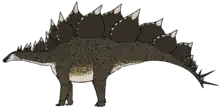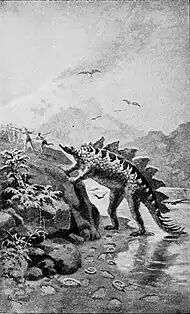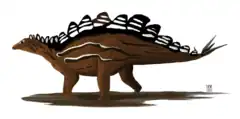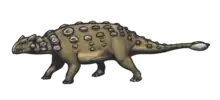| Hypsirhophus Temporal range: Late Jurassic, | |
|---|---|
 | |
| Hypothetical life restoration of H. discurus | |
| Scientific classification | |
| Domain: | Eukaryota |
| Kingdom: | Animalia |
| Phylum: | Chordata |
| Clade: | Dinosauria |
| Clade: | †Ornithischia |
| Clade: | †Thyreophora |
| Suborder: | †Stegosauria |
| Family: | †Stegosauridae |
| Subfamily: | †Stegosaurinae |
| Genus: | †Hypsirhophus Cope, 1878 |
| Type species | |
| †Hypsirhophus discurus Cope, 1878 | |
Hypsirhophus (meaning "high roof"; often misspelled "Hypsirophus") is a genus of stegosaurian dinosaurs. It contains a single species, Hypsirhophus discurus, which is known only from a fragmentary specimen. The fossil consists of partial vertebrae from the back, three from the tail, and a piece of rib.
History and classification

The first described fossils of Hypsirhophus discurus were unearthed by schoolteacher Oramel William Lucas who working for Edward Drinker Cope at Cope's Quarry 3 near "Cope's Nipple" at Garden Park, a fossil site 3.8 miles northeast of Canon City, Colorado, and came from the Tithonian strata of the Upper Jurassic.[1][2] The fossils now accepted as Hypsirhophus were fragmentary and came from one individual, containing: a dorsal vertebra, 2 partial neural spines, 2 caudal vertebral centra, and a rib fragment.[3][2] These fossils were then sent to Cope, who briefly described them in 1878 as part of the Bone Wars, a competition between Cope and the Yale paleontologist Othniel Charles Marsh over fossils from the American West.[4][3] Cope incorrectly grouped a theropod femur, possibly from Allosaurus, found nearby into the specimen causing him to believe it was a theropod related to Laelaps or Megalosaurus and possibly even synonymous with a species of the former that he described, Laelaps trihedrodon.[3][5][6] The generic name of Hypsirhophus means "high roof" after the tall anatomy of the dorsal vertebrae, while the specific name hasn't been translated.[6] The next year in 1879, Cope named another species, Hypsirhophus "seeleyanus", based on several vertebrae, limb bones, and teeth from an unknown locality in Colorado that have since been lost, but were theropod fossils instead of stegosaurian.[4][2][3] Cope also inadequately named the species, making it a nomen nudum.[3][2] The holotype of Hypsirhophus discurus was transferred to the American Museum of Natural History after Cope's death in 1897, where it's under specimen number AMNH 5731.[5][2]

It wasn't until many years later and the descriptions of complete Stegosaurus skeletons that Hypsirhophus was classified as a stegosaur, with Cope's rival Marsh placing Hypsirhophus in Stegosauridae in 1892.[7] Some later researchers have considered Hypsirhophus to be a synonym of Stegosaurus,[5] or a nomen dubium,[8] though Kenneth Carpenter and Peter Galton have suggested that it is distinct and valid based on differences in the vertebrae.[1][2]
Description
Due to the fragmentary nature of the type specimen, lack of description, and the single known specimen, little is known from Hypsirhophus. Kenneth Carpenter noted that it could be diagnosed by: Circular fossa between postzygapophyses in Hypsirhophus versus vertical grooves in Stegosaurus, Median ridge extending from base of postzygapophyses to neural canal versus no ridge [a groove in Stegosaurus ungulatus (as S. stenops)], In cross-section of pedicel, the anterior surface is convex versus being concave in Stegosaurus.[2][1] The dorsal vertebrae are very tall, at 47 centimeters tall despite being incomplete and some of the largest dorsals known.[8][1]
References
- 1 2 3 4 Carpenter, K (1998). "Vertebrate biostratigraphy of the Morrison Formation near Canon City, Colorado". Modern Geology. 23: 407–426.
- 1 2 3 4 5 6 7 Galton, P.M. (2010). "Species of plated dinosaur Stegosaurus (Morrison Formation, Late Jurassic) of western USA: new type species designation needed". Swiss Journal of Geosciences. 103 (2): 187–198. doi:10.1007/s00015-010-0022-4. S2CID 140688875.
- 1 2 3 4 5 Maidment, Susannah C. R.; Norman, David B.; Barrett, Paul M.; Upchurch, Paul (2008-01-01). "Systematics and phylogeny of Stegosauria (Dinosauria: Ornithischia)". Journal of Systematic Palaeontology. 6 (4): 367–407. doi:10.1017/S1477201908002459. ISSN 1477-2019.
- 1 2 Cope, E. D. (1879). New Jurassic Dinosauria. American Naturalist, 13, 402-404.
- 1 2 3 Gilmore CW (1914). "Osteology of the armored Dinosauria in the United States National Museum, with special reference to the genus Stegosaurus". Series: Smithsonian Institution. United States National Museum. Bulletin 89. Government Printing Office, Washington (89).
- 1 2 Cope, E. D. (1878). A new genus of Dinosauria from Colorado. American Naturalist, 12, 181.
- ↑ Marsh, O. C. (1896). The dinosaurs of North America. US Government Printing Office.
- 1 2 Maidment, S. C. R.; Brassey, Charlotte; Barrett, Paul Michael (2015). "The Postcranial Skeleton of an Exceptionally Complete Individual of the Plated Dinosaur Stegosaurus stenops (Dinosauria: Thyreophora) from the Upper Jurassic Morrison Formation of Wyoming, U.S.A." PLOS ONE. 10 (10): e0138352. Bibcode:2015PLoSO..1038352M. doi:10.1371/journal.pone.0138352. PMC 4605687. PMID 26466098.

